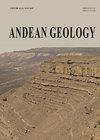智利安托法加斯塔地区Lila cordon和Sierra de Almeida的cambo - ordovic岩基深成岩的地球化学
IF 1.2
4区 地球科学
Q3 GEOLOGY
引用次数: 0
摘要
在智利北部Antofagasta地区,沿Cordón de Lila和Sierra de Almeida发育了一上寒武统-奥陶系(490-460 Ma)岩基,属于法马蒂纪弧。岩体类型可分为花岗闪长岩和二长花岗岩两种。第一个岩性分布在西部边缘,第二个岩性分布在岩基的东部。两种岩性在地球化学上的主要区别是第二种岩性相对于第一种岩性在硅和钾方面的富集。大部分花岗闪长岩为铝质或位于铝质田与过铝质田之间。二长花岗岩多为过铝质。这些岩体(主要元素、微量元素和稀土元素)的化学成分可以推断出这两组岩体的共同起源,它们都是由分离结晶演化而来的基性岩浆。两种岩性的组成差异,特别是偏铝或过铝性质的差异,可以用原始岩浆与长英质地壳岩石不同程度的相互作用来解释。本文章由计算机程序翻译,如有差异,请以英文原文为准。
Geoquímica de las rocas plutónicas del batolito cambro-ordovícico del Cordón de Lila y de la Sierra de Almeida, Región de Antofagasta, Chile
An Upper Cambrian-Ordovician (490-460 Ma) batholith crop out along the Cordón de Lila and Sierra de Almeida, in the Antofagasta region, northern Chile, which belongs to the Famatinian arc. Two plutonic rock types can be distinguished: granodiorites and monzogranites. The first lithology is positioned along an occidental fringe in as much the second is located along an oriental part of the batholith. The main geochemical difference between the two lithologies is the enrichment in silica and K of the second with respect of the first one. Most of the granodiorites are metaluminous or are located between the metaluminous and peraluminous fields. The monzogranites are mostly peraluminous. The chemical composition of the plutons (mayor and trace elements and rare earth elements) allow to infer a common origin for both groups, from a mafic magma that evolved by fractional crystallization. The difference in composition between both lithologies, specially the meta or peraluminous character, can be explained by means a different degree of interaction of the original magma with the felsic crustal rocks.
求助全文
通过发布文献求助,成功后即可免费获取论文全文。
去求助
来源期刊

Andean Geology
地学-地质学
CiteScore
3.90
自引率
0.00%
发文量
17
审稿时长
>12 weeks
期刊介绍:
This journal publishes original and review articles on geology and related sciences, in Spanish or English, in three issues a year (January, May and September). Articles or notes on major topics of broad interest in Earth Sciences dealing with the geology of South and Central America and Antarctica, and particularly of the Andes, are welcomed.
The journal is interested in publishing thematic sets of papers and accepts articles dealing with systematic Paleontology only if their main focus is the chronostratigraphical, paleoecological and/or paleogeographical importance of the taxa described therein.
 求助内容:
求助内容: 应助结果提醒方式:
应助结果提醒方式:


